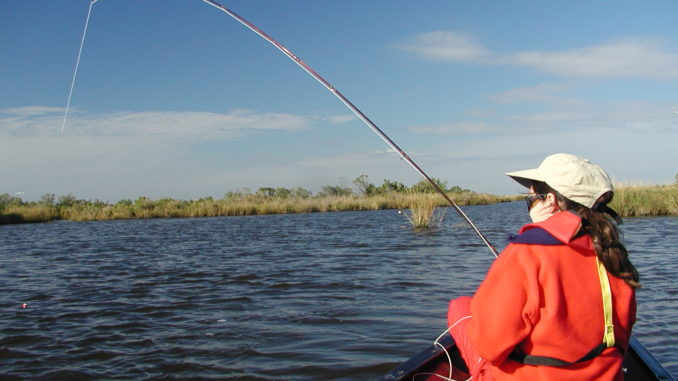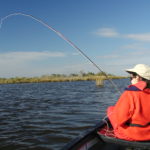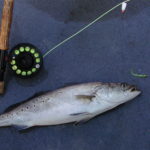
Pop goes the word
The recent passing of Steve Jobs, co-creator of the first personal computer, gave this columnist reason to think of all the contributions that computers have made in our lives.
One example is a vocabulary that never existed before.
Ms. Luster, my high-school English teacher, probably never would’ve imagined words like “blog,” “email” and “Google,” much less being used as verbs. Regardless, she would’ve demanded that they be properly conjugated.
Take the verb “blog,” originated from the noun “web log” which is an online posting of personal thoughts or knowledge.
“He blogs about fly tying” would be the third-person singular present tense.
“I’m blogging about fly tying” would be the present participle.
“They blogged about fly tying” would be the plural past participle.
That’s our English grammar lesson for the month.
Recently there was a post on a saltwater fly fishing forum, where the author stated that he had trouble catching specks until he “vosied his leader.”
Frequent readers to this column know what a VOSI is. Yet I’m always baffled how many folks fly fish the marsh without ever using the “flyrodder’s popping cork.”
VOSI is an acronym for “Vertically Oriented Strike Indicator.” Almost 20 years ago, I came up with this name after reading that a flyfisher was banned from a river for using a cork. When someone would ask me, “Is that a cork?” my response would be, “No, that’s a VOSI. It was originally developed by NASA for the space program.”
I kid you not, some folks actually believed this!
Today fly anglers can openly admit they use a popping cork without ridicule or reprisal!
Making a VOSI is simple: Cut a styrofoam perch float in half. Then using a Dremel cone bit, sand out a concave face on the flat section of each half.
The concave face of the VOSI faces the fly line, while the stopper plug is inserted on the fly end. The VOSI is placed 2 to 3 feet above a weighted fly.
When the VOSI is popped, it not only creates a sound that grabs the attention of speckled trout, it imparts a vertical motion to the fly that drives them crazy! Ask any veteran trout fisherman, and they’ll tell you that jigging a lure results in more strikes. It’s my belief that trout are vertically-challenged.
Prior to the VOSI, the most popular drop-leader technique for specks was a “popper-dropper,” where a popper was placed a few feet above a weighted fly. The upside was the possibility of catching two-at-a-time. The downside was that the popper hook often entangled the trailing dropper fly.
One of the biggest mistakes saltwater anglers make when rigging up a “popper and dropper,” or even just a popper, is using too heavy a leader at the end of their fly line. The monofilament connection between the fly line and popper/VOSI must be absolutely straight (no memory) or else stripping the line will not make an effective “pop.”
One trick that my buddy Dan Weber has come up with is using a furled leader as an elongated butt section, then tying on 3 feet of light tippet (usually 12 pounds) to the end of the furled leader. The VOSI goes at the top end of the tippet section.
Furled leaders provide the mass needed to turn over big flies. But they’re also memory-free. For those reasons, they’ve become wildly popular for casting bass bugs and drop leader combinations.
Recently, a fishing partner told me that he’s “vosiing his poppers.” Wow … my innovation taken to the present participle!
Mike loves to fish Port Sulphur in November. A couple years back, he encountered birds diving in Bay Sanbois. He motored slowly over to the commotion and found good-sized specks busting up on minnows.
Mike decided to switch from a drop leader — in this case, a VOSI and weighted fly — to a topwater popper. But he forgot to slide off his VOSI, and the result was a “popper-popper” combination.
Too impatient to correct the rigging, he cast out. Trout blew up on both the VOSI and the popper almost every cast, but few hookups. So he cut off the VOSI, thinking more hookups on the popper by itself. There was a significant dropoff in the number of strikes. Mike then re-added a VOSI, and the strikes picked up again!
This concept shouldn’t come as any surprise to those who frequently fish western coldwater trout waters. On Montana’s Madison River, hopper-hopper or hopper-dropper combinations have long been used by guides and veteran anglers to improve their luck. Often trout come up for the first fly, wary to eat, but the sight of the second fly makes them less discreet.
The same applies to warmwater fishing. On trips to the Atchafalaya Basin, the late Tony Accardo used to pile bream and sac-a-lait into his ice chest using one of his Ligons attached a couple feet below a Wildcat popper.
Tippets
For the next two months, speckled trout will be thick in brackish bayous, canals and interior lakes. Colder water is typically clearer water, and that favors flies! A game plan for putting a nice mess of fish in the box starts off with poppers around sunrise, switching to weighted flies like Clouser minnows and Charlies under a VOSI around mid-morning, then finishing the day with poppers near sunset. Pencil poppers, Pete’s Perch Float Popper and Skipping Bugs work great for both reds and specks. Best colors are metallic gold, black/chartreuse, green/white and red/white.
At low-tide periods, especially the day after frontal passage, you’ll find reds, drum and sheepshead “backing” along pond edges and over shallow flats. Be respective of duck hunters. Let them have the morning period. This time of year, good redfish action happens any time of the day.
Spoonflies, seaducers, gummy minnows and crab patterns will all catch reds. Big weighted flies like the Sqwirm Charlie and the Redchaser will arouse the larger fish.
Lakes D’Arbonne, Bruin, Sibley and Larto are a few of my top crappie locations this month. The hottest two flies this past year have been “Death to Crappie” and the “Concordia Special Fluff Butt.”
You may have to google to find recipes for these flies, but they are easy to tie. Colors like black/chartreuse and blue/white are best. For fishing near structure, try suspending these flies under a tiny float.
Upcoming Events
• Nov. 4-6 — Southern Flyfishers Rendezvous. Annual gathering of flyrodders from Louisiana, Texas, Oklahoma, Arkansas and elsewhere. North Toledo Bend State Park, Zwolle. No planned activities, but lots of fly tying, food and fishing. Fee includes lodging and meals. For more info, contact Kyle Moppert at 225-343-0867 or visit laflyfish.com.
• Nov. 12 — Fly Tying Class, Ascension Parish Library, 708 South Irma Boulevard, Gonzales. Time 9 a.m. to noon. No fee. Basics of tying fresh and saltwater flies (Poppers, ‘Lil Tommies, Rooters, Rednecks). For more info, call instructor Darrell Crawford (225) 644-7989.
• Nov. 28 — Red Stick Fly Fishers Fly Tying Clinic, Bass Pro Shops, Denham Springs. Time 7 p.m. to 9 p.m. No fee. Beginners welcome. Instructor will demonstrate two popular fly patterns for the marsh.
• Dec. 1 — North Louisiana Fly Fishers Workshop. Shady Grove Recreation Center, 3949 Wayne Ave, Bossier City. Time 6 p.m. No fee. The NLFF club workshops focus on various aspects of fly fishing, such as casting, knot tying and fly tying. All skill levels are welcome. For more info, go to www.northlaflyfishers.org.




